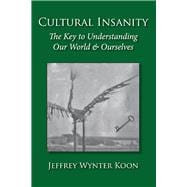The concept of cultural insanity provides a better way of understanding much of what is wrong in our society and in the world today—and how it got that way—and some ways to improve it.
Where our own culture is involved, we and all other individuals in our society are party to it, yet largely blind to it, and to varying extents partake of at least some of its craziness. Accordingly, correctly grasping the idea of cultural insanity will also reveal pathways to improve one's self-understanding, develop a more realistic worldview, and help liberate the mind from the unseen mesh of cultural implants and biases.
Cultural insanity is characterized foremost by features of a society/culture that unnecessarily thwart the development of human potential. (My compilation here of the "elements of human development" describes most of these potentials.) Because "unnecessarily thwart" means that there must be viable alternatives, allowances may need to be made for a culture's level of technology, its people's levels of consciousness, and more.
Part One includes the theory and methods for cultural insanity analyses, along with many examples of current and recent cultural insanities from U.S. politics, history and the environmental realm. Parts Two through Four are historical case studies that consider witch-hunts, religion vs. science in the Middle Ages, and the discoveries of geologic time and evolution. With the distance in time to keep bias at bay, the reader can see a cultural retrogression toward greater cultural insanity, a culture that resisted possibilities to advance human potential, and a once-buried (and thus discounted) cultural insanity that was exposed but is still present today. The reader can also more fully understand the methods and nuances used in the analyses and recognize parallels in society's problems today.
Virtually (if not) all cultures are, or have tendencies to be, culturally insane in some respects, and it is immensely important to understand why this is so. To some extent the causes of such general cultural problems are rooted in the evolutionary history of our species, including the way our brains operate. Awareness of the nature of these processes, along with more fully conscious thinking, and the use of evidence, reason and scientific methods, can reduce the negative effects these influences have on culture(s). The same techniques are needed to break out of our enculturated mental straitjackets. To liberate oneself from cultural insanity, it is important to incorporate all the important relevant facts. You may need to face head-on any competing values or worldviews. And exclude stereotypes, fake facts, and one-sided interpretations based on cherry-picked data; and discount all nonrepresentative anecdotes/stories. Information silos will mislead you.
And with more of our cultural blinders off, or at least perforated, we can get a better grasp of the problems and damages that cultural insanities cause our society—and envision better alternatives to improve the development of human potential. Many of our society's problems are U.S.A.-centered. But there are also damages which our country, along with many others, are causing. Together, we are causing a Sixth Extinction and overpopulation; we are overconsuming the Earth's resources and depositing waste and chemicals everywhere; we are causing global warming; and we are living in a world in which many "social" media are manipulating our grasp of facts and reality for their own benefit. Too often these cultural insanities are being denied, ignored, or otherwise given low priority and, hence, are frequently being left in exacerbated forms for subsequent generations. Some of these cultural insanities endanger all humanity. A greater liberation from our own culture's insanities offers new hope for the development of human potential without so much destructiveness.








